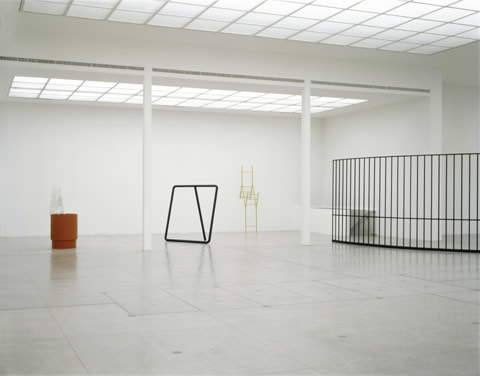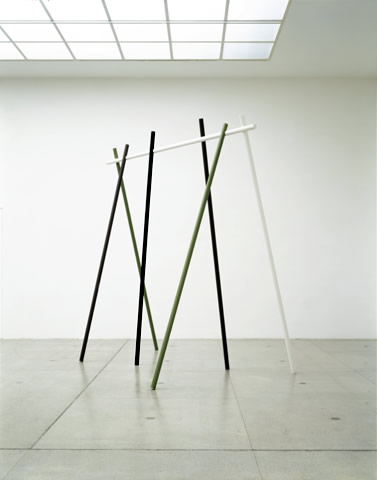zandpoortvest 10
be 2800 mechelen
t +32 15 336 336
m (b) +32 478 811 441
m (d) +32 475 477 478
Figure/Ground | Werner Feiersinger

installation in Transit Mechelen, 2009
In his photographic works, collages, sculptures, and Contradictions between the dogmatic theoretical demands of classical Modernism and later classical Modernist works in architecture that do not strictly fulfill these demands provide the material for Werner Feiersinger’s work. He is interested in the mystification of Modernism as an embodiment of functionality and rationality, a myth generated by the written statements of prominent figures of the period and by their almost equally dogmatic and hence “uncritical” reception.
The sculptor and photographer is not prepared to let this go unnoticed. On the contrary, he is motivated precisely by these inconsistencies and contradictions, producing ambivalent objects and photographs of subject matter that is well enough known but from a surprisingly unconventional point of view capable of bringing different and unexpected aspects to light.
The precision with which Feiersinger executes his works is matched by the scope of his preparation, research, and engagement with a given architectural or artistic canon. These are taken mostly from Modernism, ranging from architects like Le Corbusier, who helped to define the canon, through Erich Mendelsohn, whose expressive style subverted the orthodox rules, and on to artists who left their mark on Minimalism: Donald Judd, who focused on mastering the material, but more especially Tony Smith with his anthropomorphic references and Anne Truitt with her associative links, both of whom worked, strictly speaking, against the canon.
For Werner Feiersinger, an exhibition in the Secession’s Hauptraum – itself an icon of modern architecture and the “ideal” exhibition space of the white cube – is a fitting challenge. He has made a new work: the delicately curved steel structure (17 m long, 2.80 m tall), a quotation from Le Corbusier’s Villa Savoye, becomes the architecturally dominant element, structuring the space. The full-size reconstruction, a detail from the villa’s entrance area, is accurately based on Le Corbusier’s plans, although it differs from the actual building.
Around this work, Feiersinger has positioned other new sculptures. His objects are embedded in a complex network of references from the history of art and architecture and from his own life. Ladders, shovels, scaffolding, or equipment for games feign utility; formal associations with tools or means of production are evoked and playful links established. On closer inspection, however, it becomes clear that the objects are thoroughly dysfunctional. They have become emancipated from their ostensible concrete meaning and are going their own ways. This ambivalence, which extends to Feiersinger’s treatment of surfaces, characterizes his works.
The same is true of his photographs, which show canonical buildings from architectural history, but from an unorthodox, subjective angle. These “standards” are juxtaposed with structures and situations of architecture in use, presented as being totally equal in value. The photographs thus not only question and undermine a visual convention, but also testify visually to an aesthetic quality identified by Feiersinger in what is supposedly inadequate or inappropriate. Although in understated form, the paradoxical dogma of the undogmatic is a thread running through the whole show.
Secession, February-April 2008, Wien


Secession, 2008, Stahl, Grundierung
article in Frieze magazine, april 2002
CV
1966 geboren in Brixlegg / born in Brixlegg (AT)
1984–1989 Hochschule für angewandte Kunst, Wien / University of Applied Arts, Vienna (AT)
seit 2006 Gastprofessor an der Hochschule für Angewandte Kunst in Wien / since 2006 Visiting Professor at the University of Applied Arts, Vienna (AT)
lebt und arbeitet in Wien / lives and works in Vienna (AT)
Einzelausstellungen (Auswahl)/ Solo Exhibitions (Selection)
2008
Wiener Secession, Wien (AT)
2006
Skulpturen, Schloss Damtschach, Wernberg (AT)
2005
Galerie Martin Janda, Wien (AT)
Österreichisches Kulturforum, Bratislava (SK)
2004
Freespace, Z33, Hasselt (BE)
2001
Galerie Martin Janda, Wien (AT)
1999
Raum Aktueller Kunst Martin Janda (mit Christine Hohenbüchler), Wien (AT)
1998
Jos Jamar Galerie (mit Jon Thompson), Antwerpen (NL)
Gruppenausstellungen (Auswahl)/ Group Exhibitions (Selection)
2007
Who remembers where they are from?, Galerie Martin Janda, Wien (AT)
HARD ROCK WALZER - Contemporary Austrian Sculpture, Villa Manin Centro
d’Arte Contemporanea, Codroipo (IT)
Grund, Künstlerhaus Bregenz, Bregenz (AT)
Reduzierte Aussagen, Kunsthaus Mürz, Mürzzuschlag (AT)
On Peter Watkins, Galerie Martin Janda, Wien (AT)
2006
Blasser Schimmer, Kunstraum Niederösterreich, Wien (AT) http://www.frieze.com/issue/review/werner_feiersinger/
2005
Kollaborationen, Tiroler Kunstpavillon, Innsbruck (AT) (Kat.)
Socha A Objekt X., Bratislava (SK) (Kat.)
Blickwechsel n°2., MUMOK Kärnten, Klagenfurt (AT)
In den Wäldern, Kunsthaus Mürz, Mürzzuschlag (AT)
Bilder hauen – Skulpuren bauen, ZOOM Kindermuseum, Wien (AT)
Galerie Maerz, Linz (AT)
2004
Tour – Retour. Saint Etienne – Innsbruck, Kunstpavillon, Innsbruck (AT) (Kat.)
Vienna Coffee Table, Galerie Bernhard Knaus, Mannheim (DE)
Adriana Czernin, Werner Feiersinger, Gregor Zivic c/o Galerie Martin Janda, Österreichisches Kulturforum Prag (CZ)
Artist’s Collection, Galerie der Stadt Schwaz, Schwaz (AT)
2003
Transfer Wien, Aktuelle Kunst aus Wien in der Sammlung Falkenberg,
Hamburg (DE)
Zugluft / Aktuelle Kunst aus Wien, Kunst 2003, Zürich (CH)
Discussing Sculpture, Galerie Martin Janda, Wien (AT)
L’art dans la ville. 9 artistes autrichiens, Saint Etienne (FR) (Kat.)
2002
Bilanz 2001, Tiroler Landesmuseum Ferdinandeum, Innsbruck (AT) (Kat.)
2001
Unter freiem Himmel, Skulptur im Schlosspark Ambras, Galerie Elisabeth und Klaus Thoman, Innsbruck (AT) (Kat.)
2000
Die Desorientierung des Blickes, De Beyerd, Breda (NL) (Kat.)
1999
Freespace, NICC Antwerpen (BE) (Kat.)
1998
Sculptura Austriae, Galerie Elisabeth und Klaus Thoman, Innsbruck (AT) (Kat.)
1996
De Appel Foundation, Amsterdam (NL) (Kat.)
1995
Quarters, Oude Bonnefantenmuseum, Maastricht (NL)
